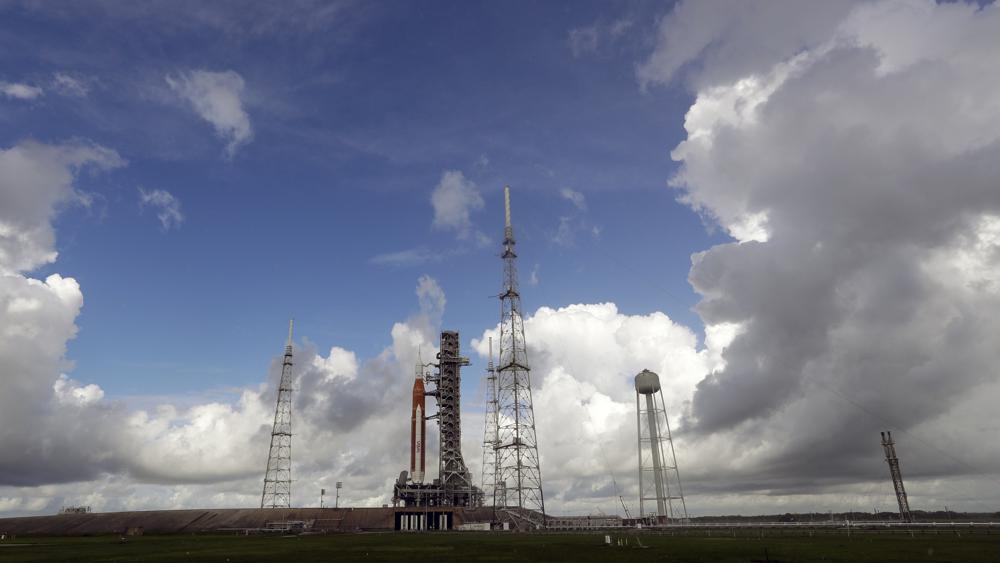By MARCIA DUNN
CAPE CANAVERAL, Fla. (AP) — NASA called off the launch of its mighty new moon rocket on its debut flight with three test dummies aboard Monday after a last-minute cascade of problems culminating in unexplained trouble related to an engine.
The next launch attempt will not take place until Friday at the earliest and could be delayed until mid-September or later.
The mission will be the first flight in NASA’s Artemis project, a quest to put astronauts back on the moon for the first time since the Apollo program ended 50 years ago.
As precious minutes ticked away Monday morning, NASA repeatedly stopped and started the fueling of the Space Launch System rocket because of a leak of highly explosive hydrogen, eventually succeeding in reducing the seepage. The leak happened in the same place that saw seepage during a dress rehearsal in the spring.
The fueling already was running nearly an hour late because of thunderstorms off Florida’s Kennedy Space Center.
Then, NASA ran into new trouble when it was unable to properly chill one of the rocket’s four main engines, officials said. Engineers struggled to pinpoint the source of the problem well after the launch postponement was announced.
Mission manager Mike Sarafin said the fault did not appear to be with the engine itself but with the plumbing leading to it.
Complicating matters, as engineers were trying to troubleshoot that problem on the launch pad, yet another hydrogen leak developed, this one involving a vent valve higher up on the rocket, Sarafin said.
“This is a very complicated machine, a very complicated system, and all those things have to work, and you don’t want to light the candle until it’s ready to go,” said NASA Administrator Bill Nelson.
Referring to launch delays, he said: “It’s just part of the space business and it’s part of, particularly, a test flight.”
The rocket was set to lift off on a flight to propel a crew capsule into orbit around the moon. The six-week mission was scheduled to end with the capsule returning to Earth in a splashdown in the Pacific in October.
The 322-foot (98-meter) spaceship is the most powerful rocket ever built by NASA, out-muscling even the Saturn V that took the Apollo astronauts to the moon.
The dummies inside the Orion capsule were fitted with sensors to measure vibration, cosmic radiation and other conditions during the shakedown flight, meant to stress-test the spacecraft and push it to its limits in ways that would never be attempted if humans were aboard.
Asked about the possibility of another launch attempt on Friday, Sarafin said, “We really need time to look at all the information, all the data. We’re going to play all nine innings here.”
Even though no one was on board, thousands of people jammed the coast to see the rocket soar. Vice President Kamala Harris and Apollo 10 astronaut Tom Stafford were among the VIPs who arrived.
Assuming the shakedown flight goes well, astronauts will climb aboard for the second Artemis mission and fly around the moon and back as soon as 2024. A two-person lunar landing could follow by the end of 2025.
The problems seen Monday were reminiscent of NASA’s space shuttle era, when hydrogen fuel leaks disrupted countdowns and delayed a string of launches back in 1990.
Later in the morning, NASA also officials spotted what they feared was a crack or some other defect on the core stage — the big orange fuel tank with four main engines on it — but they later said it appeared to be just a buildup of frost in a crevice of the insulating foam.
Launch director Charlie Blackwell-Thompson and her team also had to deal with sluggish communication between the Orion capsule and launch control. The problem required what turned out to be a simple fix.
Even if there had been no technical snags, thunderstorms ultimately would have prevented a liftoff, NASA said. Dark clouds and rain gathered over the launch site as soon as the countdown was halted, and thunder echoed across the coast.
___
The Associated Press Health and Science Department receives support from the Howard Hughes Medical Institute’s Department of Science Education. The AP is solely responsible for all content.









